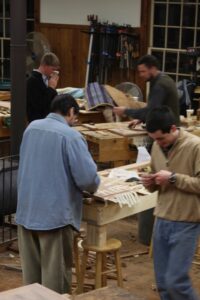What’s your sell-by date
With all the ridiculous talk of our biggest UK apprenticing provider being a massive supermarket chain you can begin to realise the problem we craftsmen are up against when people are hardwired to think stacking shelves and recycling the boxes tidily even merits the use of the title let alone provide the substantial apprenticeship it takes to become as skilled as an artisan maker.

Theoretical education may also be involved, informally via the workplace and/or by attending vocational school while still being paid by the employer. Unfortunately, here at my local college I was talking to a member of staff about training young apprentices. I asked him what happened in the trade school. He commented, “Well, the schools locally serve to filter out that that can make it academically and go on to higher education and those that will not. They direct the s–t to us and we work with the s–t! This is what the man genuinely believed because it was in fact a reality that trade school for 6 decades is where the “thick” ones are sent to by way of channelling. How we change this mentality I don;t know because a local retired joinery teacher from the same college who worked there 3 decades ago and none of this in his heart. He invested in the young people who went to the college and even now still wanted to invest in that he brought ten saws to the New Legacy School of Woodworking so that his tools could continue to be used by students.
Like everything else in our modern world, substantive skill has been dumbed down to intolerable levels and much if this occurred when we handed over craft education to a system that set itself up as the expert authority outside of the traditional guilds. Unfortunately the guilds to in many cases were equally subjected to corrupted oversight. Reversing trends often meets stiff opposition from many spheres because it challenges the status quo and non-conformity is seen as a form of rebellion, but we working craftsmen have a responsibility to work out ways to make certain our craft stays vibrant, creative and alive and I am not just talking about woodworkers fitting plastic windows and doors or working with MDF and fibreboards made for machine either. Its skilled workmanship and mentoring that protects our craft and deposits it into the hearts and minds of upcoming craftsmen and women. This is what I am talking about. It’s respect for young people and respect for older people who can both carry this forward.

